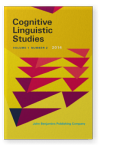Temporal prepositions explained
Cross-linguistic analysis of English and Swedish unit of time landmarks
To what extent can factors such as the size of a unit of time landmark and zoomed in effects explain the patterns of temporal prepositions in English (Lindstromberg, 1998/2010)? How important are these factors cross-linguistically? This paper is a corpus linguistic analysis of unit of time landmarks in English in and on instances, and in their Swedish equivalents, i and på instances. My aims are to investigate how temporal in and on relationships are construed in terms of spatial ones and to identify shared and differing patterns between these two closely related languages. Shared patterns may provide clues in regard to which factors are salient when time is construed in terms of space. Differing patterns highlight the fact that a given way of construing time in terms of space is not the only alternative. Systematicity at this level of abstraction is potentially useful for the second language (L2) learner.
References
Bąçzkowska, A
(
2011)
Space, time and language: A cognitive analysis of English prepositions. Bydgoszcz: Wydawnictwo Uniwersytetu Kazimierza Wielkiego.

Boroditsky, L., & Ramscar, M
(
2002)
The roles of body and mind in abstract thought.
Psychological Science, 13(2), 185–188.


Brugman, C
(
1981)
Story of over. MA thesis. University of California, Berkeley.
Casasanto, D., & Boroditsky, L
(
2008)
Time in the mind: Using space to think about time.
Cognition, 106(2), 579–593.


Coventry, K.R
(
2001)
Object-specific function, geometry, and the comprehension of in and on.
European Journal of Cognitive Psychology, 13(4), 509–528.


Coventry, K.R., & Prat-Sala, M
(
2001)
Object-specific function, geometry, and the comprehension of in and on.
European Journal of Cognitive Psychology, 13(4), 509–528.


Dewell, R.B
(
2007)
Moving around: The role of the conceptualizer in semantic interpretation.
Cognitive Linguistics, 18(3), 383–415.


Field, J
(
2008)
Bricks or mortar: Which parts of the input does a second language listener rely on?’ TESOL Quarterly, 42(3), 411–32.


Filipović, L., & Jaszczolt, K.M
Filipović, L., & Jaszczolt, K.M
Herskovits, A
(
1986/2009)
Language and spatial cognition: An interdisciplinary study of the prepositions in English. London/New York: Cambridge University Press.

Johansson Falck, M
Other ways of construing space: In and on from a cross-linguistic perspective. Unpublished manuscript.
Johansson Falck, M
What trajectors reveal about time metaphors: Corpus analysis of English and Swedish. Manuscript under review.
Lakoff, G
(
1987)
Women, fire, and dangerous things: What categories reveal about the mind. Chicago: University of Chicago Press.


Lakoff, G., & Johnson, M
(
1999)
Philosophy in the flesh. New York, NY: Basic Books.

Langacker, R
(
2002)
Concept, image, and symbol: The cognitive basis of grammar (2nd ed.). Berlin/New York: Mouton de Gruyter.

Liamkina, O.A
(
2008)
Making dative a case for semantic analysis: Differences in use between native and non-native speakers of German. In
A. Tyler,
Y. Kim &
M. Takada (Eds.),
Language in the context of use: Discourse and cognitive approaches to language. Berlin, Germany: Mouton de Gruyter.

Nesset, T
(
2011)
Space-time asymmetries in Russian prepositions: Preliminary analysis.
Poljarnyj Vestnik, 141, 45–62.


Núñez, R.E., & Sweetser, E
(
2006)
With the future behind them: Convergent evidence from Ayamara language and gesture in the crosslinguistic comparison of spatial constructs of time.
Cognitive Science, 301, 401–450.


Odlin, T
(
2008)
Conceptual transfer and meaning extensions. In
P. Robinson &
N. Ellis (Eds.),
Handbook of cognitive linguistics and second language acquisition. New York/London: Routledge.

Özçalişkan, Ş
(
2005)
Metaphor meets typology: Ways of moving metaphorically in English and Turkish.
Cognitive Linguistics, 16(1), 207–246.


Özçalişkan, Ş., & Slobin, D.I
(
2003)
Codability effects on the expression of manner of motion in Turkish and English. In
A.S. Özsoy,
D. Akar,
M. Nakipoğlu-Demiralp,
E. Erguvanlı-Taylan &
A. Aksu-Koç (Eds.),
Studies in Turkish linguistics (pp. 259–270). Istanbul, Turkey: Boğaziçi University Press.

Radden, G
(
2003)
The metaphor TIME AS SPACE across languages’. In
N. Baumgarten,
C. Böttger,
M. Motz &
J. Probst (Eds.),
Übersetzen, Interkulturelle Kommunikation, Spracherwerb und Sprachvermittlung - das Leben mit Mehreren Sprachen. Festschrift für Juliane House zum 60. Geburtstag.
Zeitschrift für Interkulturellen Fremdsprachenunterricht [Online], 8(2/3): 226–239.

Talmy, L
(
2000)
Toward a cognitive semantics. Cambridge, MA: MIT press.

Tyler, A
(
2012)
Cognitive linguistics and second language learning: Theoretical basics and experimental evidence. New York, NY: Routledge.


Tyler, A., & Evans, V
(
2007)
The semantics of English prepositions: Spatial scenes, embodied meaning and cognition. Cambridge, England: Cambridge University Press.

Vandeloise, C
(
1990)
Representation, prototypes and centrality. In
S. Tsohatzidis (Ed.),
Meanings and prototypes: Studies in linguistic categorization. London, England: Routledge.

Vandeloise, C
(
1994)
Methodology and analyses of the preposition in
.
Cognitive Linguistics, 5(2), 157–84.


Cited by
Cited by 3 other publications
Egan, Thomas & Hildegunn Dirdal
Kristensen, Line Burholt & Marie-Louise Lind Sørensen
2023.
På, i, for, or til: A comparative analysis of prepositions in the writing of L1 and L2 Danish users.
Nordic Journal of Linguistics ► pp. 1 ff.

This list is based on CrossRef data as of 1 july 2024. Please note that it may not be complete. Sources presented here have been supplied by the respective publishers.
Any errors therein should be reported to them.
